Genre: Platformer Developer: Tec Toy Publisher: Tec Toy Players: 1 Released: 1995
The Frustrating Vacation of Woody Woodpecker… now there’s an uncomfortably foreboding title right there. Little hint to future game developers, don’t call your own game frustrating – especially if this little factoid turns out to be true! The title is immensely fitting, except for one thing: a vacation this game ain’t.
For those of you who don’t know who Woody Woodpecker is, he is one of those screwball animated anthropomorphic animals, created and brought to life by cartoonist Walter Lantz. As a contemporary of other similarly wacky figures like Daffy Duck or Bugs Bunny, this feathered fiend gained popularity fast due to his erratic behaviour and crazy antics. Whereas Bugs Bunny was more of a good-natured loony who acted (mostly) out of self-defense, Woody Woodpecker was more of an aggressive, if not outright psychotic character (like in the short The Barber of Seville, where he flat-out menaces a guy with a straight razor for almost three minutes – without any reason at all!). Audiences loved his antics though. So eventually he received his own syndicated TV-show – which meant of course, that his more aggressive tendencies got smoothed out in favor of a more family-friendly approach. But nevertheless, the wacky woodpecker with his trademark laugh still remained a more insane sort of character than most of the other types encountered in a Saturday morning cartoon. The show itself got more of a mixed reception, although it gained quite a following in South America.
Due to his popularity in Brazil (where he went by the name of Pica Pau), Tec Toy somehow acquired a license to produce a game based on the character. If certain sources are to be believed, it was kind of a troubled production, with disagreements about the actual license handed out to Tec Toy and the overall treatment of the material. As the rumor goes, the game took roughly four years to get finished. Nevertheless, in 1996 (though the in-game credits of the Mega Drive version say 1995), Ferias Frustradas do Pica Pau was released exclusively in Brazil, for both the Mega Drive and the Master System (which was still going strong in that country).
The game weaves pretty much all the known characters from the TV show into its backstory. Here, Woody Woodpecker and his friends are heading out for a peaceful vacation. Woody’s nemesis Buzz Buzzard (or, as he’s called here, Zeca Urubu), however, is miffed because he didn’t get invited. So, in a completely understandable and not at all disproportionate act of retaliation, Buzz kidnaps all of Woody’s friends and threatens to kill them (for example by sawing Andy Panda in half with, fittingly, a buzz saw). So it’s up to our wacky woodpecker to save the day.
Even though the entire in-game text is in Portuguese, the game is pretty easy to understand. There are two difficulty settings: Easy (facil) skips a good deal of the levels and allows Woody to perpetually use his pecking attack by keeping the B-Button pressed. The hard mode (dificil) adds a second section to each stage and has more aggressive enemies. Both difficulty settings have their share of frustrating issues, though, so let’s tackle them one after another.
The gameplay is typical platforming share. Woody has to cross the level until he reaches the exit. Enemies can be dispatched by the aforementioned pecking. C causes the woodpecker to jump. By double-tapping into a certain direction Woody starts into an impressive sprint. Every once in a while, the game introduces a few new sections or gameplay mechanics to mix things up a little: In level two, the home of the sleepwalking Wally Walrus (or Leôncio as he’s known in Brazil), Woody gets a horn that he can use to startle the slumbering mammal in order to pass by unharmed. Later levels include a ride in a motorboat and (at least on hard mode) a downhill-skiing section. There’s also a jetpack power-up that lets Woody freely and speedily fly around – in theory, at least. The game definitely tries to offer some variety.
This would all be very nice if the controls weren’t so horribly broken. The jumping controls in particular are awful. Unless Woody isn’t moving, he only jumps straight upward. Once he does move, however, he practically flies across the screen, as his jumping speed is way faster than his standard walk. So it is very hard to pinpoint a jump without accidentally bumping into something. Also, whenever Woody gets an extra tool (like the aforementioned horn or, in another level, a brush), he only can utilize it by simultaneously pressing A+B together. This is incredibly awkward and does at times not even work properly. Why couldn’t the creators just map the function to the A button, which is otherwise only used in very few moments when Woody has to go through some kind of teleport barrels? Moments where, I have to mention, these special items never come into play! Also, the sprint function also only works whenever it feels like it.
The level design is, for the most part, plain awful. Enemies (especially once with projectile attacks, like acorn-throwing squirrels) are often placed in such a way that once they pop up on screen, you can’t avoid being hit by them. Also, some enemies (like the bats in stages two and six) just suddenly start popping up from out of nowhere. The game tries to counteract this by granting you a very generous energy bar. However, you will receive so many cheap hits during the game that you’ll eventually run out of energy regardless.
The levels themselves are also full of questionable design choices, especially in hard mode. For example, in the second section of stage one, after passing a lot of pits where a drop down leads to certain death (and where, due to the awful jump mechanics, it’s easier to jump straight on an enemy and allow yourself to get hurt, hoping the knockback will throw you onto a platform you otherwise couldn’t reach), you come to a dead end. Only when pecking a nearby tree (an act you’ll never repeat in the game, by the way), you get a hint (in Portuguese, naturally): “E salto inicial é o mais dificil” (literally translated to: “The first jump is the hardest”). What the game means by that is that in order to progress, you have to drop down the nearest pit – simple, right? This is thankfully the only part of the game where you have to solve a “riddle” like that, but there are other problems as well. The skiing section, for example, is just one long, boring slope, that goes straight down; no curves, no inclines, nothing. However, you have to jump to avoid rocks that cause damage or drop down into instant death traps, all in a previously not encountered, breakneck speed. Once you manage to best all these issues, the game is a short affair: the whole thing with its six stages can be bested in less than half an hour in hard mode.
The graphics aren’t all that impressive, either. The game uses a simple drawn cartoon style, with no kinds of shading or special outlines whatsoever. The color depth also doesn’t make use of the full palette the Mega Drive has to offer. It mostly uses plain colors that are clearly separated from one another, which looks more like something found in a Sunday morning newspaper – only very crudely drawn. The artwork in the cut scenes in particular look more like a child’s sketch than professional work; I’ve seen way better graphics created after a few sessions with Art Alive than what this game has to offer.
The sound is also rather dull. Viewers of the TV show might recognize a rendition of the main theme during the menu and the first stage of the game. It sounds pretty hollow, not making use of many channels. Practically all the audio tracks in the game are like that. There is worse out there, but the compositions are just very unremarkable. What you’re going to hate, though, is the audio cue that plays every single time you pick up an item (be it power-up, key, bonus points or whatnot): a little jingle representing Woody Woodpecker’s trademark laugh. Though it is one of the most recognizable features of the character, it gets annoying very, very fast!
Sub-par graphics, annoying audio, poor level design, broken controls – this title practically contains all the hallmarks of a truly bad game. And yet, in the end, I just can’t bring myself to completely dislike it! Even though executed badly, you can see that a lot of thought went into the game. The programmers tried hard not to create a standard, run-of-the-mill platformer, but rather bring some fresh variety into the field. The game may be tough, it may be broken, it may be – in an unintentionally ambiguous allusion to its own title – immensely frustrating! But it certainly isn’t boring. Would I recommend tracking it down for a purchase? Hell no; being released exclusively in Brazil, the game is very hard to get hold of, and the eBay prizes are ridiculous (though if you want, you could try getting a copy at Mercado Livre). So, unless you seek out rarities, I wouldn’t recommend buying the game. But should you by any chance come across it for cheap, or otherwise have an opportunity to play it, you might give it a try. Who knows, maybe you’ll like it.
SCORE: 4 out of 10

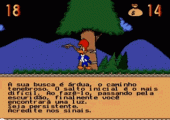

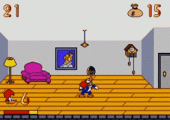
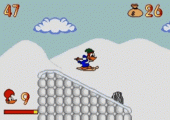
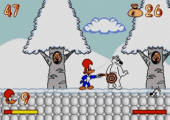
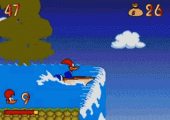

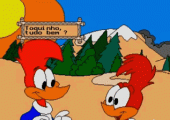
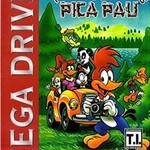
Isn’t “just get the games released” the motto for just about anything Tectoy releases?
Well, by the time this game was released, Sega was starting to discontinue the Genesis/Mega Drive. So there were very few releases from the system wich, in Brazil, was still very strong. So, from 1995 and beyond we’ll see many titles produced by tectoy to supply this market. Unfortunatly Tectoy is no Sega, both in resources and know-how, that’s why we got, in Brazil, crappy titles like this one. Nevertheless, a few Tectoy exclusives were ok, like Duke Nuken.
It’s games like this one that make me wonder just how hard can it be to program jumping for a 2D sidescrolling game… Also, you have to wonder whether the people who made this (and other games like it) have ever played a video game in their life. Chances are if they had, they would notice some major differences between how jumping is supposed to work, and how it works (or doesn’t) in their game. Then there’s the whole question of just who decided to let it go to market, and whether the thing was even play tested before release.
I suppose since the game – reportedly – took so long to get done, eventuellay the decision was made was to “just get it out there”. This would explain the sort length and the horrible implementation of some otherwise pretty good ideas…